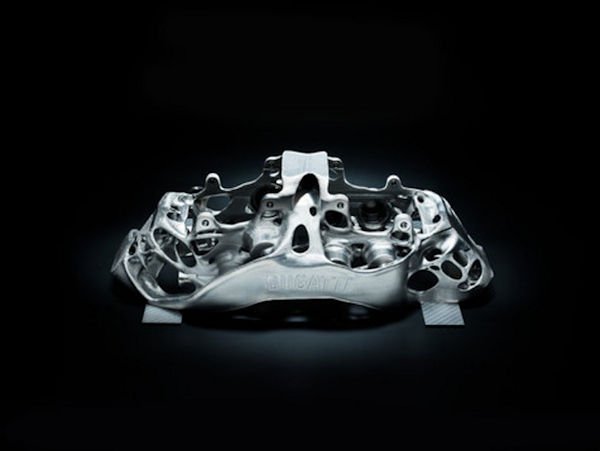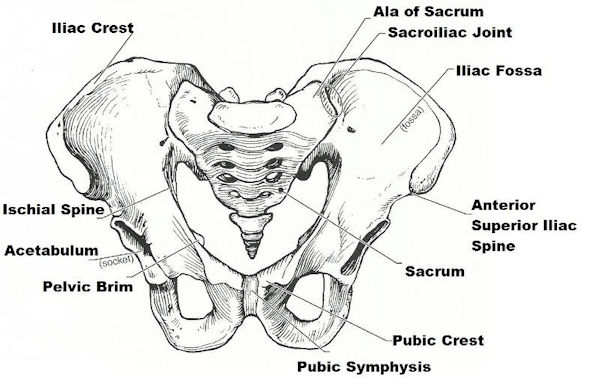The day has finally come. They called me mad. They called me a dreamer. They said that it would never happen, but it could and it finally did! Generative design and additive manufacturing have barged their way into the consumer market, guns blazing, with Bugatti’s totally awesome eight-piston monoblock brake calliper.
https://newatlas.com/bugatti-3d-printed-titanium/53082/

The Incredible Brake Calliper
Behold, the triumph of engineering design and manufacturing. This brake calliper weighs 2.9kg – over 40% lighter than its predecessor – and yet has the same, if not better, performance characteristics. How is such a dramatic improvement possible? This article will not concern itself with the specs of this design. Rather, this article will concern itself with the design’s conception and manufacture, and what monumental things it heralds for industry.
Millions of Years in the Making: Generative Design
Take a moment and have a good look at the design above. If you noticed its biomorphic structure and thought it looked a little like bone, you may be right on the money. These are not the straight lines and regular curves of human designers; this body – at least in part – was designed by a machine. This is generative design.
Generative design is a form-finding process that takes an evolutionary approach to creating geometry – a radical departure from the traditional design methods of today. Rather than a human operator creating 3D geometry in the hope of fulfilling a function (bottom-up), a human will describe the problem to the machine, and it will produce the geometry (top-down). Inputs can include things like material, boundary conditions, forces, interfaces, requisite stiffness, bounding box dimensions, vibrational characteristics, etc. The computational requirements for a complex set of inputs are astonishing, but manageable by the astronomical computational power we possess today.
It is almost poetic that such an evolutionary approach – when directed to produce a shape that is as lightweight, strong and as stiff as possible – should produce a structure so similar to our own mammalian skeletons. And of course, this is perfectly understandable; one would have to be pretty confident in one’s own engineering to think you could best billions of years of mutation and selection. So we end up with a biomorphic structure, arguably better than anything a human could have come up with manually. What a beautiful circle – to have ended up with designs so like ourselves.

See the video below for more.
https://www.youtube.com/watch?v=72DZqunUpKQ
The Complexity Comes for Free: Additive Manufacturing
Of course, you might be quick to argue that it’s not feasible to manufacture such complicated geometries, and until recently you would have been right to. Traditionally, engineering designs have hovered around relatively simple geometries (such as prisms) for the simple fact that at the end of the day, the thing needs to be made. If they are to be made manually, complicated geometries can become expensive or even impossible. But this has been turned around entirely by additive manufacturing; with additive manufacturing, the complexity comes for free.
In the case of Bugatti’s brake calliper, the process of selective laser melting (SLM) was used. The idea is simple: lay down an incredibly thin layer of metal dust (in this case, titanium alloy Ti 6Al-4V), and use lasers to melt the dust particles together. This not only forms a single layer in the design, but fuses it to the layer below it. Layer by layer, dust is laid and melted until you finally have the completed part. The beauty of this process is that it cares not one bit about the absurdity of your design’s geometry – despite its large size and bewildering complexity, Bugatti’s brake calliper was 3D-printed in only 45 hours. The biomorphic geometry produced by the generative design process, so difficult to produce by hand, was a cakewalk for the clever SLM printer.
Why does this matter?
While this isn’t the first instance of generative design or of additive manufacturing being used in machine parts, it is one of the first times they have been used in a high-end consumer product. The design – representing such a dramatic improvement on its traditionally-designed predecessors – clearly demonstrates the capabilities and possibilities of these emerging technologies. While our work as human engineers, designers and manufacturers are far from over, I can see the day setting on our traditional bottom-up approaches. And while this may necessitate the acquisition of new skills and new modes of thinking, I believe the forthcoming days in industry heralded by designs such as these are brimming with exciting possibilities.


